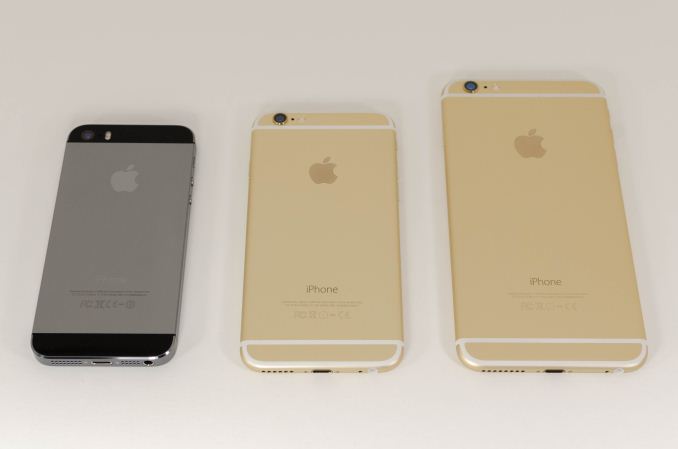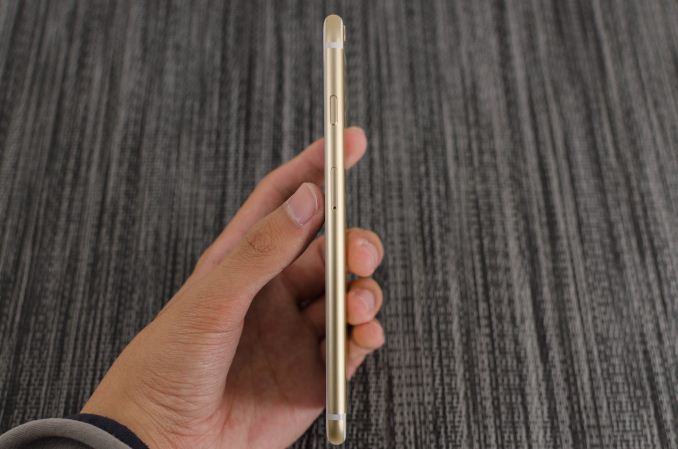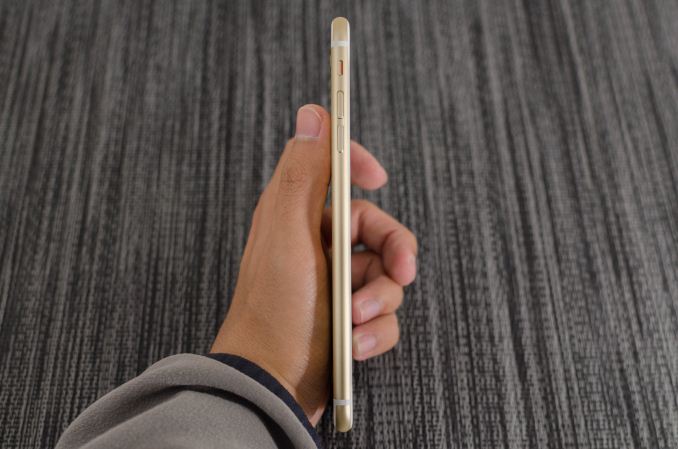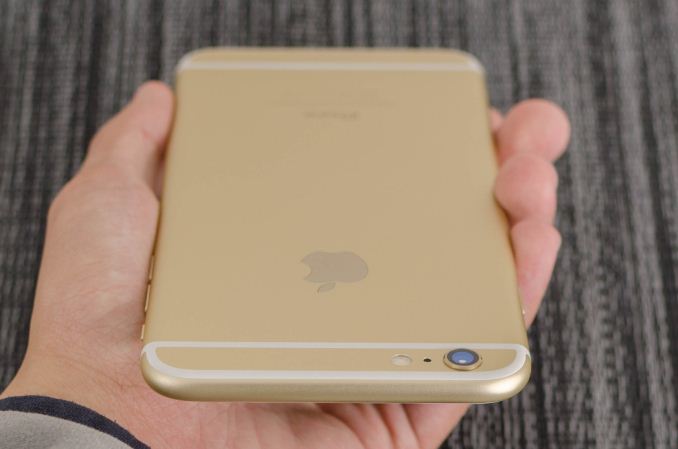The iPhone 6 Plus Mini-Review: Apple's First Phablet
by Joshua Ho on September 30, 2014 8:00 AM EST- Posted in
- Smartphones
- Apple
- Mobile
- iOS
- iPhone 6 Plus

While we’ve also written about the iPhone 6, the iPhone 6 Plus needs its own review in order to really understand the various features of the device that would otherwise be buried in the context of the iPhone 6. Without question, this device represents a significant departure from the way Apple has competed in the smartphone space. Until now, Apple hasn't competed in the phablet space and has thus avoided competing with Galaxy Note line that has been established as the dominant phablet for the past 3-4 generations. As a result, Apple occupies a fast-follower position at best.
This brings us to the iPhone 6 Plus, which really is an extension of the iPhone 6. Both phones share the same SoC, NAND configurations, front and rear camera sensors, LED flash module, industrial/material design, TouchID home button, earpiece and speaker configuration, WiFi/BT chipset, modem, and button layout. At this point, I’m going to stop listing similarities because the iPhone 6 Plus is interesting for its differences. Unlike similarities, the differences are simple. The iPhone 6 Plus is bigger, the display has higher pixel density, the camera has optical image stabilization, and iOS 8 has new app designs to take advantage of the larger screen. The iPhone 6 Plus is also more expensive, with the 16GB version starting at the same price as the 64GB version of the iPhone 6.
While I’ve already discussed the design of the iPhone 6, it’s important to see whether the same design translates to the iPhone 6 Plus. To this end, the iPhone 6 Plus does well. While the angular design of the iPhone 5 line would have looked and felt enormous in the hand, the shape is quite similar to the iPad line and is similarly comfortable in the hand, although the rounded edge really differentiates it, as does the control scheme. The only real issue here is that the top bezel on the front becomes surprisingly large, and this seems to contribute to a sense that the phone is top-heavy even though the phone is evenly balanced.
| Apple iPhone 5s | Apple iPhone 6 | Apple iPhone 6 Plus | |
| SoC | Apple A7 | Apple A8 | Apple A8 |
| Display | 4-inch 1136 x 640 LCD | 4.7-inch 1334 x 750 LCD | 5.5-inch 1920 x 1080 LCD |
| WiFi | 2.4/5GHz 802.11a/b/g/n, BT 4.0 | 2.4/5GHz 802.11a/b/g/n/ac, single stream, BT 4.0, NFC | |
| Storage | 16GB/32GB/64GB | 16GB/64GB/128GB | 16GB/64GB/128GB |
| I/O | Lightning connector, 3.5mm headset | ||
| Size / Mass |
123.8 x 58.6 x 7.6 mm, 112 grams |
138.1 x 67 x 6.9 mm, 129 grams |
158.1 x 77.8 x 7.1 mm, 172 grams |
| Camera |
8MP iSight with 1.5µm pixels Rear Facing + True Tone Flash 1.2MP f/2.4 Front Facing |
8MP iSight with 1.5µm pixels Rear Facing + True Tone Flash 1.2MP f/2.2 Front Facing |
8MP iSight with 1.5µm pixels Rear Facing + True Tone Flash + OIS 1.2MP f/2.2 Front Facing |
| Price |
$99 (16GB), $149 (32GB) on 2 year contract |
$199 (16GB), $299 (64GB), $399 (128GB) on 2 year contract |
$299 (16GB), $399 (64GB), $499 (128GB) on 2 year contract |
Overall, even though the iPhone 6 Plus is noticeably taller than the Galaxy Note 3 both feel similar in size. The iPhone 6 Plus is on the thinner side which makes a significant impression in the hand. At any rate, it’s physically impossible for me to use this device with one hand for most situations. It’s definitely a tablet in this sense, but in a much more compact and pocketable form factor.
"Bendgate"
Of course, drawing the comparison between the iPhone 6 Plus and Galaxy Note 3 inevitably raises the question of “bendgate”, which draws interesting parallels with “scuffgate” from the iPhone 5 generation. Unfortunately, I can’t destroy multiple review units in order to thoroughly investigate this issue. However, we can look at Consumer Reports’ data and come to a few conclusions about this problem. The first is that in the case of the iPhone 6 Plus, there appears to be an area near the bottom of the volume buttons that is a weak point as we see a clear failure of the casing in this area.
However, it seems that there is a significant amount of force needed in the first place in order to cause permanent deformation. Otherwise, everything that we’ve seen is primarily the result of fundamental differences between the two materials. It’s clear that in the case of the Galaxy Note 3 that a great deal of the structural rigidity is tied to the display itself, so the case doesn’t quite provide much in the way of protection as the polymer used is clearly in the elastic region all the way to failure. LG seems to have a different design though, as their polymer material has a clear case of brittle failure at the limit, which saved the display from shattering.
It's certainly possible to bend the iPhone 6 Plus (or really any phone or tablet), but the real issue here that hasn’t been addressed is the level of force needed to cause a certain level of elastic or plastic deformation in the material. This matters far more when discussing drop protection as the level of force in such a scenario is relatively small but applied over an extremely short period of time. There’s also no mention of force per unit area in any of these figures, so we can’t really have a serious discussion about this issue without the necessary data.














191 Comments
View All Comments
flutberf - Wednesday, October 1, 2014 - link
Android is incredibly secure. The only possible way it can get a "virus" (which on an android cannot happen anyway because of the permission system) is if someone disables 3rd party apk installs and downloads an app outside of the Play Store. Android being "open" has nothing to do with it.Also, maybe you get 10 times more calls for android phones than others because they have the vast majority of the market share?
Marthisdil - Thursday, October 2, 2014 - link
Right - because IOS has been able to be jailbroken via software since the beginning of time...IOS could have those similar bugs, especially once jailbroken...
I support hundreds of users and their devices, too. I get more calls on iphones than android phones.
yes, crapple sucks.
do i win now?
akdj - Wednesday, November 12, 2014 - link
'do i win now?'Or Do I win now?
Neither. iPhones outsell their flagship android counterparts many MANY times over. Most Android handsets are free, pay by the minute or 'tracphones'.
I love my Note 3. I've huge respect for what HTC, LC, Samsung...now, even Oppo. A name I thought only I was familiar with as an audio/video geek! ...HUGE Respect for each of their products, design choices in some cases are skeptical but the innovation that's 'pushed' BOTH Sammy and Apple to innovate, stay 'in front' of each other with the SoC races and THIS is a GOOD thing
A) you're either full of it, servicing Apple's 'hundreds of users and their devices too...and (sic) getting more support calls on iOS than Android' ...how would I know?
You're dealing with 'jail breakers' or those that brick their shit doing what they don't know how to, shouldn't be attempting and you're the only one that'll help them. Apple doesn't support jailbreaking their OS. Lotsa work goes into iOS, the App Store and payment to its developers. No reason they should. As well, jail breaking is essentially a thing of the past. iOS 8's capabilities far exceed Cydia's enticing possibilities earlier in iOS's life cycle. These days not much compelling other than side loading, screwing your device up or 'stealing' software.
None of which most buyers of an iPhone or iPad are interested in doing ...or should j say most?
Apple supports Apple. Not you. IF you're an IT manager and are operating a 'mixed' BYOD business, it's all about YOU. What you're using as your 'mainframe' (Linux? Windows? OS X?) & how you're allowing access to said workplace from outside or via VPN
I've owned every iPhone. A dozen Android phones and tabs and can honestly declare your post bullshit. Other than driving over, diving into water with, or blatantly destroying your device using software hacks/jailbreak methods beyond your scope of wisdom are all dumb, foolish things to do to a thousand dollar computer.
Why would you do it with your thousand dollar phone ...that IS a computer?
nerd1 - Wednesday, October 1, 2014 - link
Had iPhone 3gs and iPad 1. Now using android flawlessly (been through from 1.6 to 4.4)I just don't understand why people keep saying android is buggy. Apple devices were in fact more buggy to me (sudden app crashing, 'infinite apple logo' booting issues, freezing from now and then) and I had to jailbreak it to make it any useful, which brought even more bugs and issues.
Common sense - if android is too buggy to even make a call, nobody will buy android. Period.
moose0422 - Thursday, October 2, 2014 - link
I mean maybe it was just the phone I bought but Android is buggy. My Moto X wasn't the highest specced phone out there but the fact that it virtually ran the stock Android experience was what brought me to the platform. I unexpectedly became so frustrated with the OS that I had to go back to the iPhone. Between the lag, the crashing of apps, the unresponsive keyboard and random reboots I just couldn't take it anymore. Believe me I loved a lot about what Android offers. It has great features that iOS can't compete with but the overall experience just isn't the same.moose0422 - Thursday, October 2, 2014 - link
I had the 2013 Moto X and let me tell you it was an awful experience. It was the second android phone I've purchased, the first being the Samsung Captivate, and it randomly rebooted, apps crashed constantly, and the battery life was terrible. There were plenty of cool features on the phone such as Active Display, but the constant nagging of the bugs I encountered really made me hate the platform. I was an iPhone user pretty much since it was released and just recently went back to the iPhone 6 and couldn't be happier. The type of bugs I came upon just don't exist on iOS (even though it does suffer from some they are not nearly as annoying as those on Android 4.4.4). I'm hoping that Android L fixes a lot of those because the OS has a lot going for it in terms of being so open and customizable, but I was hardly impressed with my experience on KitKat and I feel that Google has lost me as a customer for foreseeable future.kmmatney - Thursday, October 2, 2014 - link
I used iPhone for 4 years, and now an Android phone for the last year. My Android phone (high end) has had a lot of bugs - serious things like not having it pause for 10-15 seconds between every word while trying to type an email (using default client). It wasn't until about a month ago that updates to Kitkat finally solved most of the issues. If I was at 2 years, I'd already have an iPhone 6+, but I'm too cheap to pay an early upgrade penalty, or buy one outright. I'm too cheap to even have a smartphone, but my work pays for the service, I just pay the subsidized phone cost. So after a year my phone finally works OK. My Nook HD+, on the other hand, well that's just buggy.OCedHrt - Thursday, October 2, 2014 - link
Because iOS doesn't show an error message when an app crashes ;)coldpower27 - Wednesday, October 1, 2014 - link
Yeah I had the S3 and switched to the iPhone 5, a much smoother overall phone. Android doesn't really come into it's own until you reach Samsung S4 and it's derivatives, and basically Note 2 and on. Android needs Quad Core for smooth operation on Samsung.If your using stock Android, the Nexus 4/5 has been a solid phone, though those are cheap phones and not really meant to compete with iPhone.
Narg - Wednesday, October 1, 2014 - link
I try so hard to convince people that if they need a cheap phone, stay away from Android. A good cheaper Nokia is a so much better experience. Android just doesn't work well on so many devices.